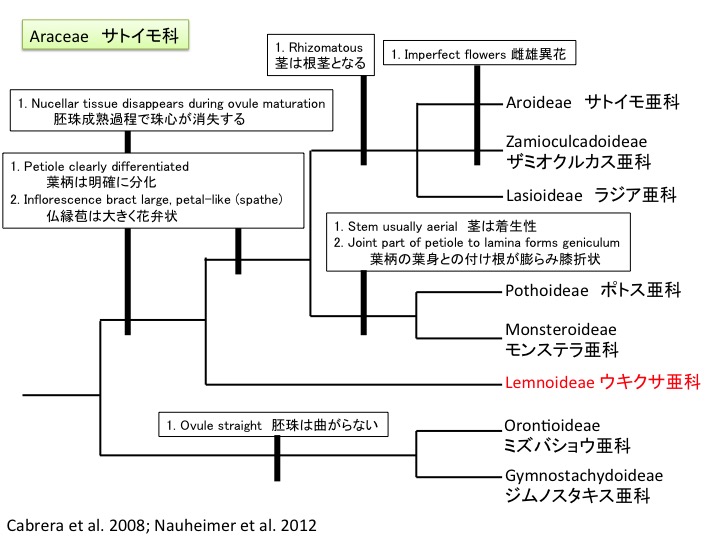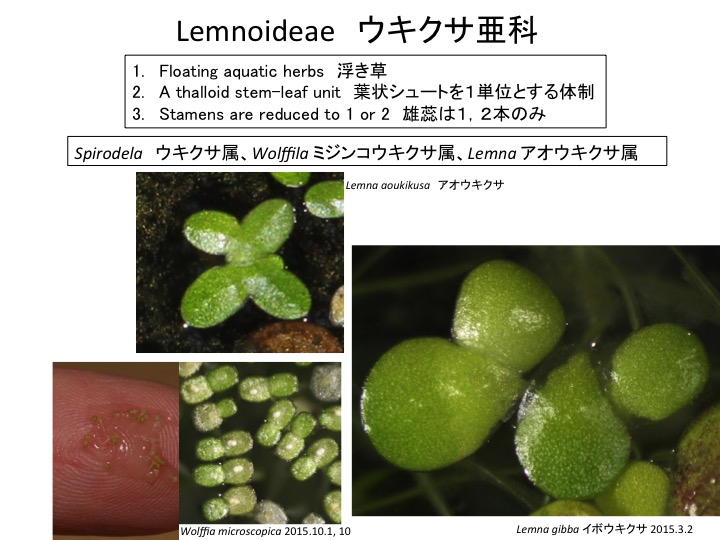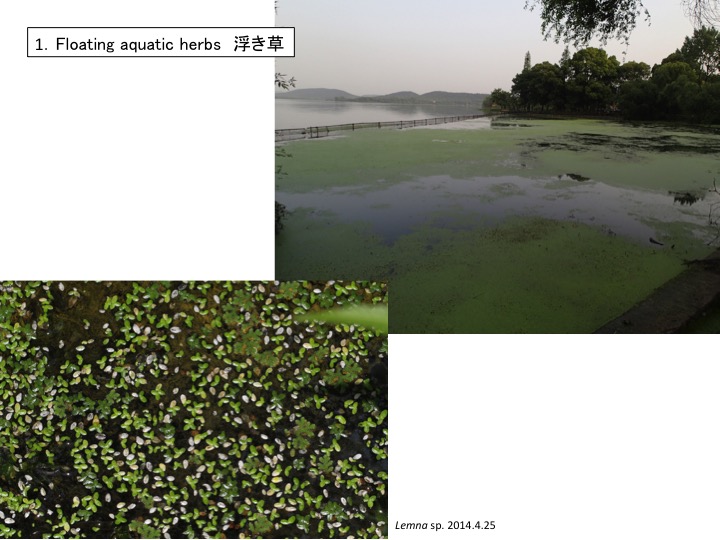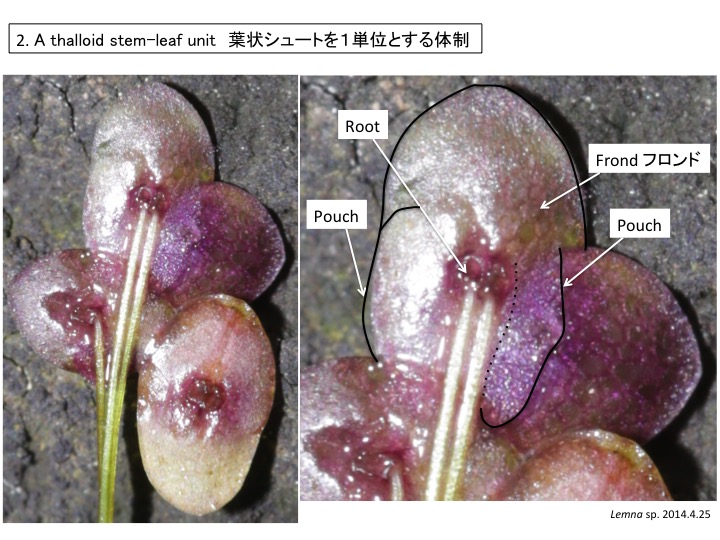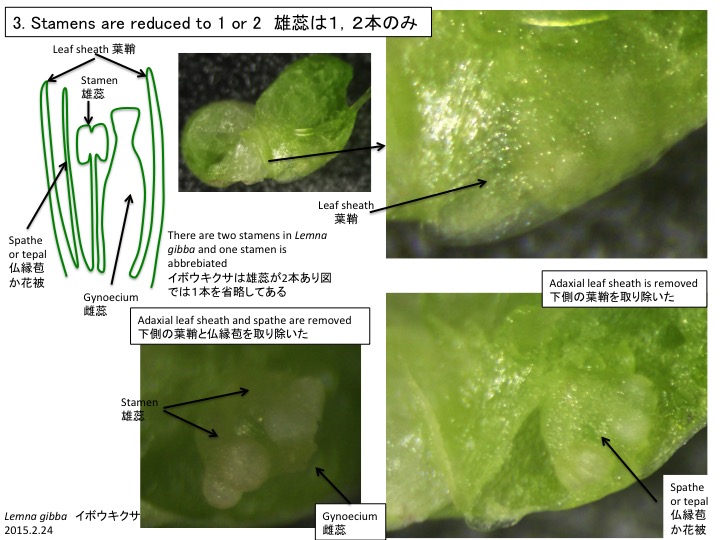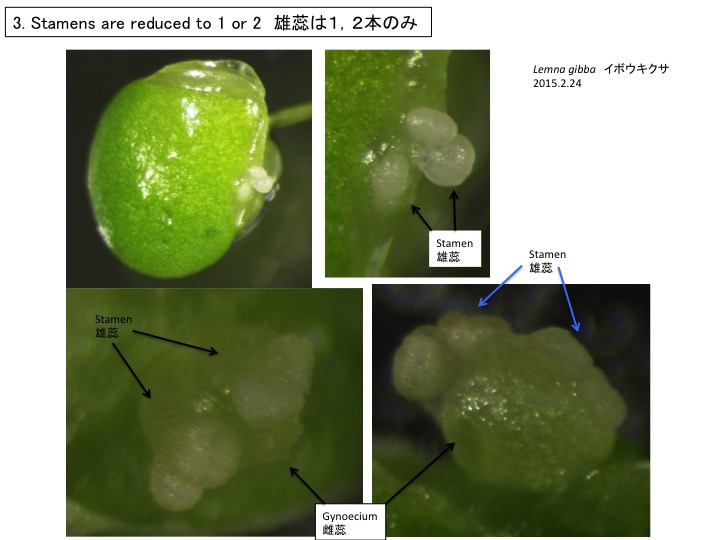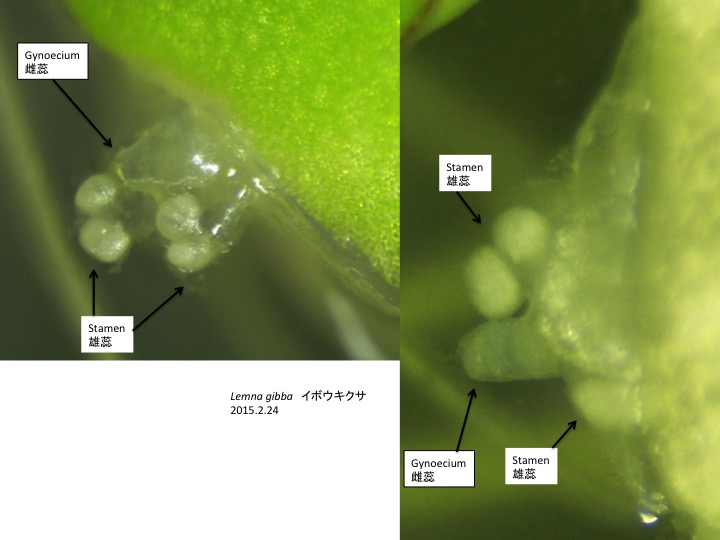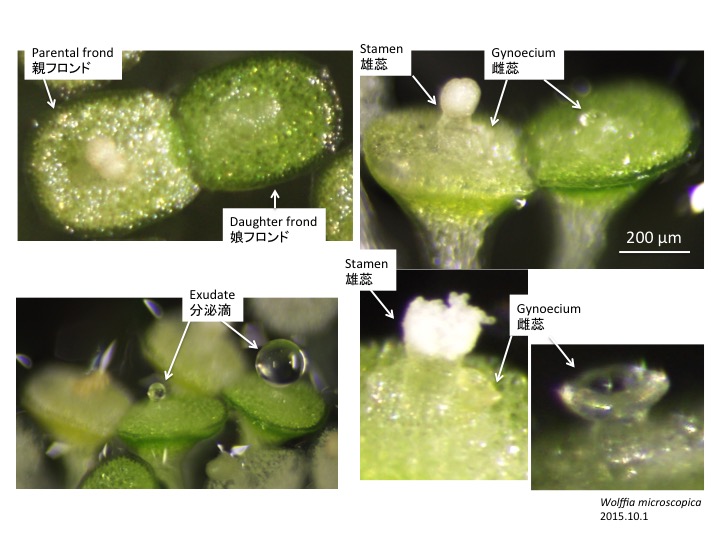ウキクサ亜科は5属約35種がほぼ世界中に分布する (Landolt 1998)。サトイモ科の他の種に較べて姉妹種から分岐後の進化速度が速いが(Nauheimer et al. 2012)、理由は不明である。ウキクサは外群と較べ、形態変化が著しいが、外群からの分化時に、進化速度の速さゆえに、形態変化を起こし、その後、形態的には安定なので、進化速度が下がったのだろうか。
Lemnoideae contains five genera about 35 species, which are distributed worldwide (Landolt 1998). Evolutionary rate is accelerated in Lemnoideae (Nauheimer et al. 2012). Relationship between the accelerated evolutionary rate and conspicuous morphological differences from sister taxa is unknown.
Landolt, E. 1998. Lemanceae. In K. Kubitzki ed. The Families and Genera of Vascular Plants. Pp. 264-270.
Nauheimer, L., Metzler, D., Renner, S.S. 2012. Global history of the ancient monocot family Araceae inferred with models accounting for past continental positions and previous ranges based on fossils. New Phytol. 195: 938-950.
ウキクサ属、アオウキクサ属、ミジンコウキクサ属のフロンド形成過程の比較から、Lemon and Posluszny (2000)はフロンドが茎と葉の発生過程を混ぜたようなものだという従来の見解を支持している。Wolffia microscopicaのさらに詳細なフロンド発生過程(Sree et al. 2000)を勘案すると、フロンドの初期過程は葉原基の無い茎頂分裂組織のようで成長につれ基部側に新しい分裂組織を切り出しているようにも見える。そして、しばらくすると分裂組織を生み出さず葉として発生する。この発生様式はカワゴケソウ科のカワゴケソウやカワゴロモに似ている。これらの植物は、葉状器官の初期原基では茎頂分裂組織で発現するSTMやWUSが検出され、原基が大きくなると葉原基で発現するARPが検出される(Katayama et al. 2010)。ウキクサ亜科においてこれらの遺伝子や、茎頂分裂組織と葉原基の区別に関わるオーキシン動態を解析すると、フロンドと他の植物の茎葉との相同性が明らかになるのではないだろうか。
Based on the comparison of development of Spirodela, Lemna, and Wolffia, Lemon and Posluszny (2000) agreed to previous ideas that the frond is a developmental hybrid of leaf and stem origin. When the more detailed development of Wolffia microscopica (Sree et al. 2000) is incorporeted, it appears for me that the early development of the frond is shoot-like with producing detached meristems as daughter fronds and that the later development is leaf-like. This developmental process looks similar to that of the Hydrobryum japonicum and Cladopus doianus in the Posdostemaceae, in which the shoot meristem genes, STM and WUS are expressed at the early primordium and then are substituted by the leaf gene ARP in the later development (Katayama et al. 2010). Analyses of these genes as well as auxin which is involved in the differentiation of shoot meristem and leaves will give insight in the homology of the frond in Lemnoideae plants.
Katayama, N., Koi, S. and Kato, M. (2010) Expression of SHOOT MERISTEMLESS, WUSCHEL, and ASYMMETRIC LEAVES1 homologs in the shoots of Podostemaceae: Implications for the evolution of novel shoot organogenesis. Plant Cell 22: 2131-2140.
Lemon, G.D. and Posluszny, U. 2000. Comparative Shoot Development and Evolution in the Lemnaceae. Int. J. Plant Sci. 161: 733-748.
Sree, K.S., Maheshwari, S.C., Boka, K., Khurana, J.P., Keresztes, A., and Appenroth, K.-J. 2015. The duckweek Wolffia microscopica: a unique aquatic monocot. Flora 210: 31-39.
従来、 ウキクサ亜科は、1つの雌花と1つの雄花からなる花序を持つボタンウキクサと姉妹関係にあると考えられていたので、ウキクサ亜科の生殖器官は、雄しべのみからなる雄花と雌蕊のみからなる雌花を総苞が被っていると考えられてきた。しかし、ボタンウキクサとは姉妹関係に無いことがわかったので、現在では、花被を持たない雄蕊と雌蕊のみからなる1つの花が、1枚の葉的器官に被われていると解釈されている (Londolt 1998)。この葉的器官は、サトイモ科の他の種の仏縁苞と相同であるか、あるいは、花被に相同なのかはわからない。
The reproductive organs of Lemnoideae have been interpreted as an inflorescence with postulating a close relationship to Pistia. However, molecular phylogeny revealed that Pistia and Lemnoideae are not closely related. Now, one reproductive unit including one or two stamens and one pistil is interpreted as a flower.
A flower without petals and petals is subtended by a membranous scale like leaf. It is unknown whether this scale is a tepal or a spathe. Here it is tentatively indicated as a spathe.
イボウキクサは2本の雄蕊と1本の雌蕊を形成する。
Lemna gibba forms two stamens and one gynoecium.
ミジンコウキクサ属は1本の雄蕊と1本の雌蕊を形成する。雄蕊は200 µmほど、雌蕊は100 µmほどである。フロンドから雌蕊が突出し、次に、雄蕊が突出する。雄蕊の基部に前に出た雌蕊が残っている。漏斗状の柱頭から分泌滴が出て受粉に機能する。Wolffia microscopicaは他のミジンコウキクサの種よりも頻繁に花を形成するので花を必要とする実験に適している。
Wolffia forms a single stamen and a gynoecium. The lengths of a stamen and a gynoecium are 200 µm and 100 µm, respectively.A gynoecium comes out and then a stamen does. At the base of the stamen, the gynoecium still remains. Exudate is formed at the tip of a funnel-like stigma for pollination. In comparison to other Wolffia species, W. microscopica frequently blooms and is useful for experiments in flowering.
Sree, K.S., Maheshwari, S.C., Boka, K., Khurana, J.P., Keresztes, A., and Appenroth, K.-J. 2014. The duckweed Wolffia microscopica: A unique aquatic monocot. Flora 210: 31-39.
イボウキクサ、Wolffia microscopicaの観察は京都大学の小山時隆先生に御教示いただきました。御礼申し上げます。
I appreciate Dr. Tokitaka Oyama for providing materials of Lemna gibba and Wolffia microscopica and kind instructions for the cultivation and flowering.

